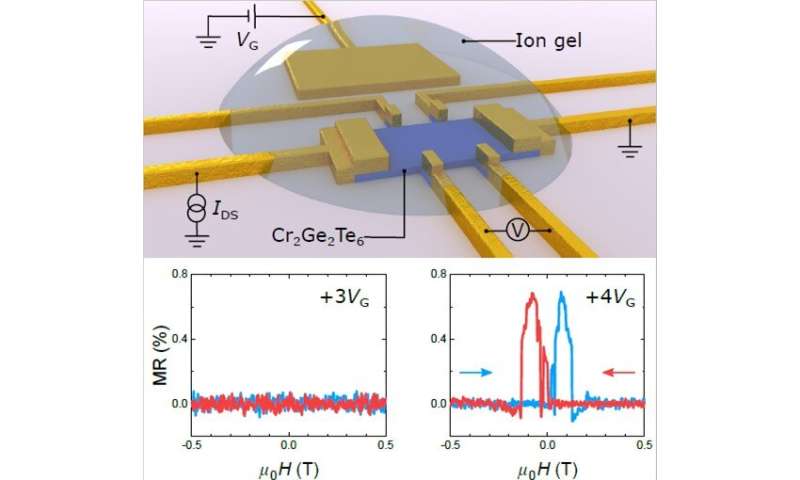
NUS physicists have demonstrated the control of magnetism in a magnetic semiconductor via electrical means, paving the way for novel spintronic devices.
Semiconductors are the heart of information-processing technologies. In the form of a transistor, semiconductors act as a switch for electrical charge, allowing switching between binary states zero and one. Magnetic materials, on the other hand, are an essential component for information storage devices. They exploit the spin degree of freedom of electrons to achieve memory functions. Magnetic semiconductors are a unique class of materials that allow control of both the electrical charge and spin, potentially enabling information processing and memory operations in a single platform. The key challenge is to control the electron spins, or magnetisation, using electric fields, in a similar way a transistor controls electrical charge. However, magnetism typically has weak dependence on electric fields in magnetic semiconductors, and the effect is often limited to cryogenic temperatures.
A research team led by Prof Goki EDA from the Department of Physics and the Department of Chemistry, and the Centre for Advanced 2-D Materials, NUS, in collaboration with Prof Hidekazu KUREBAYASHI from the London Centre for Nanotechnology, University College London, discovered that the magnetism of a magnetic semiconductor, Cr2Ge2Te6, shows exceptionally strong response to applied electric fields. With electric fields applied, the material was found to exhibit ferromagnetism (a state in which electron spins spontaneously align) at temperatures up to 200 K (-73°C). At such temperatures, ferromagnetic order is normally absent in this material.
The researchers applied large electric fields to this material by coating it with a layer of polymer gel containing dissolved ions. When a voltage is applied to the polymer gel, a layer of ions forms at the material surface, inducing strong electric fields and a high density of mobile electrons in the material. In the absence of these mobile electrons (i.e. when the applied voltage is zero), ferromagnetism occurs only below 61 K (-212°C). This critical temperature, below which ferromagnetic order emerges, is known as the Curie temperature. Above this temperature, the spin orientations are randomised (paramagnetic state), making magnetic memory operations impossible. When an electrical potential of a few volts is applied to the polymer gel, the researchers found that the Curie temperature increased by more than 100°C. Such a dramatic increase in the Curie temperature triggered by electric fields is unusual in a magnetic semiconductor. The researchers conclude that the mobile electrons induced by the ions are responsible for the observed magnetic order at the higher temperature.
The lead author Dr. Ivan VERZHBITSKIY, a research fellow in the team said, "The mobile electrons present in the material help to carry the spin information from one atomic site to another and establish magnetic order, resulting in a higher Curie temperature."
The operation temperature of these devices is still well below room temperature, which makes their implementation into current technologies impractical. However, the team aims to overcome this limitation in their future research.
"We believe that this unique phenomenon that we observed is not limited to this particular compound and can be expected in other related materials systems. With careful selection of materials, it will be possible to develop devices that operate at room temperature, which could lead to ground breaking new technologies," added Prof Eda.
Citation: An electrical switch for magnetism (2020, August 6) retrieved 6 August 2020 from https://ift.tt/30yTG9c
This document is subject to copyright. Apart from any fair dealing for the purpose of private study or research, no part may be reproduced without the written permission. The content is provided for information purposes only.
"electric" - Google News
August 06, 2020 at 06:42PM
https://ift.tt/30yTG9c
An electrical switch for magnetism - Phys.org
"electric" - Google News
https://ift.tt/2yk35WT
https://ift.tt/2YsSbsy
Bagikan Berita Ini















0 Response to "An electrical switch for magnetism - Phys.org"
Post a Comment